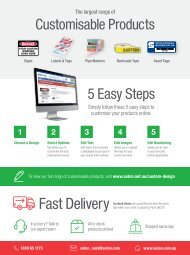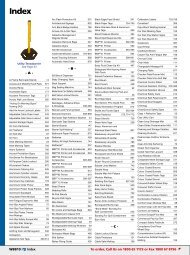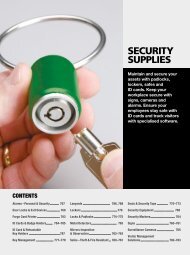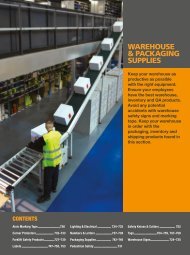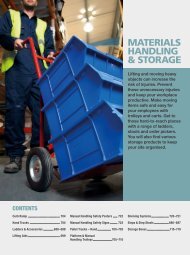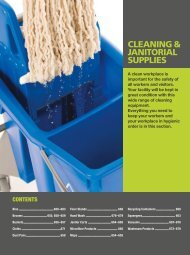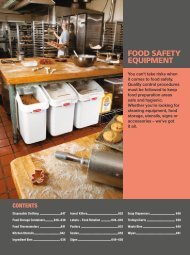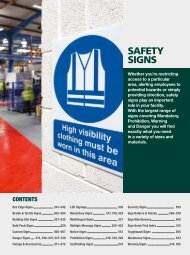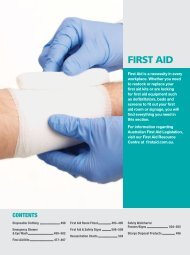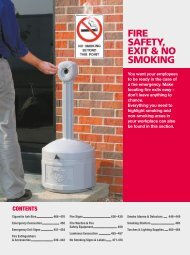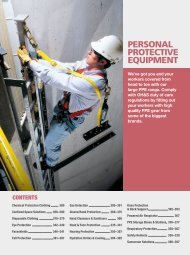Create successful ePaper yourself
Turn your PDF publications into a flip-book with our unique Google optimized e-Paper software.
<strong>First</strong> <strong>Aid</strong> In Your Workplace<br />
Australian workplaces are required to have appropriate first aid<br />
equipment available and accessible for all employees. A workplace is<br />
most commonly identified as an office, warehouse, manufacturing<br />
facility or a construction site. Trucks, delivery vehicles and company cars<br />
also constitute a workplace and require appropriate first aid to be on<br />
board.<br />
<strong>First</strong> <strong>Aid</strong> Site Assessment<br />
A periodic assessment schedule of your workplace first aid equipment<br />
will allow you to identify hazards and determine typical injuries or<br />
illness that may require rapid treatment. The assessment should also<br />
consider number of employees and work area design as first aid should<br />
be easily accessible and available within minutes of the injury location.<br />
Assessment Guidelines For Workplace <strong>First</strong> <strong>Aid</strong><br />
As business operations are constantly changing to meet customer<br />
demands your workplace first aid requirements may also<br />
require adjustments.<br />
High Risk Workplace<br />
A High Risk Workplace describes an environment where workers are<br />
exposed to hazards that could result in serious injury or illness and<br />
would require first aid. Some examples include:<br />
• Use of hazardous machinery or substances onsite<br />
• Extreme heat or cold working conditions<br />
• Risk of falls<br />
• Hazardous forms of work<br />
Low Risk Workplace<br />
A Low Risk Workplace describes an environment where workers are not<br />
exposed to hazards that could result in serious injury or illness. Offices,<br />
shops or libraries are common examples and potential work-related<br />
injuries and illnesses requiring first aid would be minor in nature.<br />
Source: Safe Work Australia, <strong>First</strong> <strong>Aid</strong> in the Workplace Code of Practice, March 2015<br />
FIRST AID RECOMMENDATIONS<br />
STEP 1.<br />
Identify potential causes of workplace injury and illness<br />
HAZARDS<br />
MANUAL<br />
HANDLING<br />
SLIPS, TRIPS<br />
AND FALLS<br />
ELECTRICAL<br />
STEP 2.<br />
Assess the risk of workplace injury and illness<br />
INJURIES<br />
Sprains, muscular strain and fractures<br />
caused by overexertion or repetitive<br />
movements.<br />
Fractures, bruises, lacerations,<br />
dislocations, concussion caused by<br />
falls from heights or uneven surfaces.<br />
Shock, burns, cardiac arrest, loss of<br />
consciousness caused by exposure to<br />
live electrical wires. Potential ignition<br />
source could cause injuries from fire.<br />
STEP 3.<br />
Assess the risk of workplace injury and illness<br />
Choose the first aid kit that is suitable for your workplace needs.<br />
REMEDY<br />
STEP 4.<br />
Review first aid to ensure effectiveness<br />
Choose additional add-on packs, to ensure the workplace contains adequate first aid on site at all times.<br />
The content is provided as a general recommendation and should not be used as a substitute for information provided by your local State or Territory Work Health & Safety regulatory authority.<br />
Order Online Today at www.seton.com.au<br />
<strong>First</strong> <strong>Aid</strong> | WB477<br />
Solutions for a Safe, Secure Workplace!



